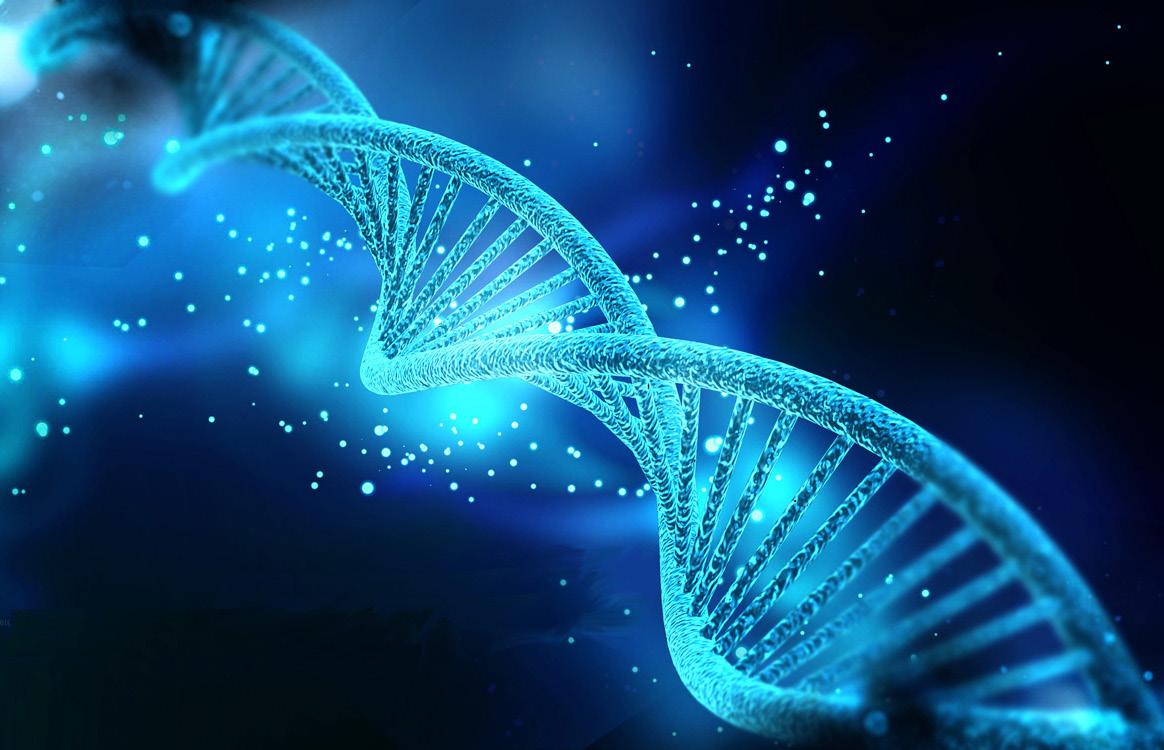
34 minute read
What About Gender
What About Gender by WILLIAM S. BRADSHAW
THANK YOU TO JORDAN SGRO FOR REVEWING AND EDITING THIS DOCUMENT.
ABOUT THE AUTHOR: WILLIAM S. BRADSHAW

Bill Bradshaw is Professor Emeritus from the Department of Microbiology and Molecular Biology at Brigham Young University where he taught and conducted research for 38 years. At BYU he served as Associate Dean of Honors and General Education. He has an A.B. degree in Biology from Harvard, and a Ph.D in Biochemistry from the University of Illinois. Bill’s interest in LGBTQ issues stems from three experiences. The first is academic. The question of the origin of homosexuality was occasionally posed by one of his students in an introductory biology, molecular biology, or cell biology course. The second arose during his ecclesiastical service in the LDS Church. With his wife, Marge, he presided over the mission of the church in Hong Kong and South Vietnam from 1971 to 1974. He subsequently served as a bishop and then a counselor in a stake presidency for married students at BYU. The third, and most important, is because Marge and Bill are parents of a wonderful gay son. Brett and his husband Jeff and their daughter Madeline live in Oakland, CA. Marge and Bill have served as Co-Chairs of LDS Family Fellowship, a support group for parents of LGBTQ children.
Copyright © 2019. Encircle: LGBTQ Family & Youth Resource Center. All rights reserved.

Our purpose here is to provide accurate information about issues surrounding being transgender, to dispel misconceptions, and to promote understanding, respect, and acceptance.
This pamphlet is not intended to be a substitute for more detailed help one might receive from counseling professionals.
In previous writings we have focused on sexual orientation: the origin and immutability of homosexuality, and an argument for love, support, and inclusion of gay, lesbian, and bisexual people. Among those included in the LGBTQ acronym set, T has received the least attention. If being gay is often hard for people in the heterosexual majority to accept – it being outside of the personal experience of those who are straight – it may be even more difficult to generate empathy for those who are transgender. It has been a long and strenuous struggle in contemporary societies to achieve a degree of equality for the sexes, let alone for people to be comfortable with the notion that there are individuals whose internal sense of gender is at odds with the one assigned to them at birth. In addition, a research effort in the physical and social sciences directed at questions of gender has lagged behind that marshalled to understand sexual orientation. In part this is because of the difficulty of finding appropriate subjects for scientific study: it is estimated that there are 700,000 transgender persons in the U.S. (0.3 % of the adult population) [1].

Table of Contents
TO START WITH...
TALKING ABOUT GENDER: AN INTRODUCTION
WHAT IS THE ORIGIN OF GENDER IDENTITY?
IN WHAT WAYS DO TRANSGENDER PEOPLE DIFFER?
POSITIONS OF PROFESSIONAL ORGANIZATIONS
CONVERSION THERAPY
WHAT DOES SCHOLARLY RESEARCH SAY ABOUT THE EFFECT OF GENDER TRANSITION ON TRANSGENDER WELL-BEING?
TRANSPHOBIA: DISCRIMINATION AND DISRESPECT
LEGAL ISSUES: LEGISLATION AND THE COURTS
THE INFLUENCE OF RELIGION
TO PARENTS, FAMILY MEMBERS, AND FRIENDS
CONCLUSION
RESOURCES
REFERENCES

To start with...
We have tried to predict who might benefit from information about the issue of being transgender. There are probably several classes of people: young trans individuals just beginning to wrestle with the very private feelings of who they are, parents whose trans child has just disclosed that struggle, other adults who interact directly with trans people through their professional or social lives – teachers or ecclesiastical leaders, distant relatives, friends of the family, the neighbors across the street, people with no immediate connection or obvious reason to care. Obviously, the needs or incentives to listen are not the same for all of these.
The challenge for a writer, then, is not just to select the right subjects, but to choose the right words. That’s not easy. Each of the groups just mentioned are diverse – the differences among individuals sometimes profound. So, for example, one trans person reading a particular definition or description may react somewhat negatively: “That wasn’t my experience!” On this issue, particular words have a history and they can be triggers that elicit strong feelings, even disapproval. So the challenge for the reader may be to exert tolerance: “If this doesn’t apply to me, maybe it does to somebody else; I’ll be patient.”
This pamphlet may introduce some people to a new frame of reference. Take, for example, the question of “biology.” That word may have a negative connotation for some, because there has been a widely-held transphobic view that gender is simply a matter of one’s sex organs: “It’s just a matter of biology.” No, as we will argue here, it is a matter of biology, but it’s the brain, not the genitalia, that determines gender.
9 We want to be helpful, no matter where you are on your particular journey. If this is all new – good. If you’re rethinking a previous position – good. If you’re prompted to read one of the references – good. If you’re willing to enter into a new conversation – good. Let’s be willing to learn from one another along the way.

Talking about Gender
The following is a description we have found useful in helping people understand issues surrounding gender. It is, in part, an attempt to use the most appropriate language that applies in specific situations. For gender that generally means one of three contexts: physical anatomy (the body, being assigned male or female at birth), gender identity (the deeply held internal sense of who one is), or gender expression (how one is presented to and perceived by others).
Some young children can accurately be described as gender diverse: they experience some disconnect with others of their same natal sex. Such persons might just have an internal sense of being different from other boys or girls, or they may behave in ways traditionally expected of the opposite sex. The latter is formally defined as childhood gender non-conformity (CGNC). Boys may avoid rough-and-tumble play, enjoy wearing girl’s clothing, or be labeled “sissies.“ Girls may enjoy physically active play, disdain girl’s clothing, or be labeled “tomboys.” Depending on their age or maturity, or in the absence of strong external disapproval from family members or others, these young children may not experience personal discomfort with such nonconforming feelings or behaviors.
Not all gender diverse children maintain gender disparity as adults, but there is a variety of outcomes for those who do. Although there is a high (but not absolute) correlation with CGNC for adult gay men (e.g. Elton John and Anderson Cooper), lesbians (e.g. Ellen DeGeneres and Rachel Maddow), and bisexual men and women (e.g. David Bowie and Lady Gaga) men and women – in general they do not desire to alter their gender. Sexual orientation (erotic and romantic attractions) is not the same as gender identity. The ongoing disconnect one might experience between one’s internal feelings and one’s sex assignment at birth is called gender dysphoria, dissatisfaction or distress – unhappiness - about being male or female.
When gender dysphoria persists into adolescence or young adulthood, some individuals, both men and women, will identify as transgender. Often (but not always) transgender people experience such a discomfort with their natal sex that they desire to change it, that is transition to the opposite sex (e.g. Jazz Jennings, Chaz Bono). This may entail a range of alterations including a change of name, the adoption of a new pronoun (he to she, for example), a change in clothing, an altered hair style, engaging in sex-hormone therapy, or surgical alteration of the chest or genitals. The term transsexual is used in the research literature for transitioned transgender persons, but is not an acceptable term in the LGBTQ community. Some in that group have found this word objectionable on the basis that their inherent gender identity deserves respect and need not be determined by some external intervention.
Some researchers [2] have proposed designations for other, rarer types of gender dysphoria in particular individuals.
It is important for family members and others to respond respectively to the feelings of the gender-questioning adolescent as some children and adolescents resolve such feelings by age 21 [see Resources, below, entry 4, p. 11]. In such cases, transitioning should be approached with caution, and with the assistance of experienced professionals.
The word queer is often used as an umbrella term for those in the LGBTQ community. The terms non-binary or genderqueer carry a generic sense of not easily fitting into either/or categories like male or female, or heterosexual or homosexual. Cisgender means the opposite of transgender, the more typical situation in which one’s natal anatomy and gender identity coincide. Intersex defines persons who as infants (and for genetic reasons) exhibited ambiguous genitalia, or who subsequently could be diagnosed as having reproductive organs different from those dictated by their chromosomal sex. With regard to sexual orientation, pansexual refers to those attracted to others regardless of their sex or gender. Persons lacking erotic feelings for either sex are asexual.
The human family is remarkably diverse with respect to sexuality and gender.

Gender Identity has a Biological Basis

What is the Origin of Gender Identity?
Convincing evidence that provides an answer to this question comes from studies of XY (male) individuals raised as females due to several nonhormonal, anatomical abnormalities of sex development [3,4]. These include failure of the penis to develop during embryonic life or surgical accidents shortly after birth. The minority of these persons were raised as boys and chose to remain male throughout life. However, among the majority, who were raised as girls, many in later life identified or lived as males. The conclusion from this research is:
“Children who were born genetically and hormonally male identified as males despite being raised as females and undergoing feminizing genitoplasty at birth. Although the cohort sizes in these studies were small, the data provide the strongest evidence for the biologic underpinnings of gender identity [5].”

In What Ways do Transgender People Differ?
The Brain (Neuroanatomy) The bed nucleus of the stria terminalis (BSTc) is a brain structure that is sexually dimorphic in humans: it exhibits a larger volume in males than in females. In transgender women (MTF) who have undergone hormone therapy , the size and neuron numbers for the BSTc were typical for that found in control females [6].
A region in the human hypothalamus, the third interstitial nucleus (INAH-3), is larger in men than in women. The volume of INAH-3 in male to female transgender persons who have transitioned is similar to that of control females [7].
The subcortical gray matter of the brain has been shown to be masculinized in transgender males (FTM) who had not been hormone treated [8], and differences in several brain structures have been demonstrated in untreated transgender females compared to male controls [9].
These results suggest that a person’s internal sense of gender is linked to the sexual differentiation of the brain. The gonads develop in fetal life before the brain is imprinted sexually, which could explain the discrepancy for some persons between sex anatomy and gender identity.
Steroid Hormone Exposure Congenital adrenal hyperplasia (CAH) is a condition that results in an intersex condition for genetic (46 XX) females. A mutant gene causes the fetus to be exposed to an abnormally high concentration of testosterone, resulting not only in abnormalities in anatomy, but a significantly higher incidence of male gender identity among these individuals [10].
Mutations in two specific genes reduce the enzymatic activities that normally control the hormone functions of testosterone. As a result, genetic males (46 XY) exhibit genital ambiguity and are usually raised as females. For these individuals, gender role changes to a male identity were reported in about 63% of each of the two affected groups [11].
One measure of embryonic exposure to testosterone is finger length. The ratio of the length of the index finger to the 4th finger (2D:4D) is established before birth, is stable by age two, and develops as a function of exposure to testosterone. 2D:4D is greater in women than it is in men. In transitioned male to female transgender persons, 2D:4D is higher than in control males and is comparable to that of control females [12].
The events occurring during sexual differentiation of the brain that control gender identity are mediated through steroid hormones.
Genetics That genes ultimately regulate gender identity is supported by twin studies. Identical twins are more often both transgender than fraternal twins (20% compared to 2.6% [13]). Being transgender may not be the results of mutations in DNA, but subtle variation in the timing, location, and intensity of normal gene expression (epigenetics).
The biological mechanisms responsible for gender identity, like those responsible for sexual orientation, can ultimately be traced to the function of genes.


Positions of Professional Organizations
The American Psychological Association makes the following statement [see Resources, below, entry 1]:
“A psychological state is considered a mental disorder only if it causes significant distress or disability. Many transgender people do not experience their gender as distressing or disabling, which implies that identifying as transgender does not constitute a mental disorder. For these individuals, the significant problem is finding affordable resources, such as counseling, hormone therapy, medical procedures and the social support necessary to freely express their gender identity and minimize discrimination. Many other obstacles may lead to distress, including a lack of acceptance within society, direct or indirect experiences with discrimination, or assault. These experiences may lead many transgender people to suffer with anxiety, depression or related disorders at higher rates than nontransgender persons.”

The American Academy of Child & Adolescent Psychiatry takes the following position [14]:
“The American Academy of Child & Adolescent Psychiatry rejects all public and private discrimination based on sexual orientation or gender identity of persons of any age particularly in the areas

of employment, military service, housing, public accommodations, membership, licensing, promotion or assignment, education, training, marriage, adoption, parenting, foster care, or qualification as an expert in a court of law. The AACAP affirms the right of all people to their orientation and identity without interference or coercive interventions attempting to change sexual orientation or gender identity.
Further, the AACAP condemns any restriction on employment or service based on sexual orientation or gender identity in positions involving the delivery of services or treatments to children and adolescents.”
Being Transgender is not a mental disorder.

Medical professionals support acceptance and reject discrimination, including efforts to change one’s chosen gender identity, and urge the delivery of appropriate health services.
Transgender identity cannot be altered through conversion therapy.

Conversion Therapy
Efforts to change people’s sexual orientation or gender identity have been documented for at least 100 years. Talk therapy is the most common therapy technique at present, although hypnosis and aversion treatments such as induced nausea or providing electric shocks were known to be used in the past. It is estimated that nearly 700,000 LGBT adults in the U.S. have experienced these kinds of therapies from either a licensed professional or religious advisor at some point in their lives [15].
Professional health associations (American Medical Association, American Psychological Association, American Academy of Pediatrics, and others) have issued public statements opposing such therapy, citing the evidence that it is ineffective and harmful [15]. As of January 2019, fifteen states and the District of Columbia have passed laws banning conversion therapy for people under the age of 18 when it is provided by a licensed provider in exchange for payment. These statutes do not apply to clergy or religious counselors. Thus, thousands of people will continue to receive this inappropriate treatment.

Investigators at Cornell University asked this question in their review of all peer-reviewed published articles on gender transitioning in English between 1991 and June 2017 [16]. The results of 56 studies that comprised primary research were examined. The conclusion of 52 (93%) was that well being was better. This included improved quality of life, greater relationship satisfaction, higher self-esteem and confidence, and reductions in anxiety, depression, suicidality and substance use. None showed overall harm as a result of transition. The overall finding of this analysis follows:
“This search found a robust international consensus in the peerreviewed literature that gender transition, including medical treatment such as hormone therapy and surgeries, improves the overall wellbeing of transgender individuals. The literature also indicates that a greater availability of medical and social support for gender transition contributes to better quality of life for those who identify as transgender.”
Transphobia: Discrimination and Disrespect
In the past 10 years a number of studies have documented harassment, abuse, violence, and discrimination experienced by transgender people. A comprehensive review of these publications provides useful details [17]. The overall incidence of these unfortunate events is 40-70%. They fall into categories such as employment, housing, education, legal protection, and access to healthcare services. Equally important, it has been demonstrated that this discrimination leads to marginalization and social isolation. Many transgender people report depression, stress, internalized stigma, and suicidal ideation as a result of the way they are treated.
One of these reports for the period 2008 - 2009 reveals the following alarming numbers with respect to health care. Twenty-eight percent of transgender adults experienced harassment in medical settings, 19% were refused health care, 28% postponed care because of discrimination, and 50% of those who did receive care had to teach their clinicians about what was needed to assist transgender persons [18]. The authors recommend that “Clinicians can actively support their health by addressing the risk of verbal and physical assault, helping with emotional challenges related to disclosing gender identity to family and friends, and discussing medical options for gender affirmation (e.g., hormone therapy)”.
In another national study, 40% of transgender adults reported having made a suicide attempt, nearly all before the age of 25 [19].
What is helpful? The studies referred to above document factors that promote resilience and coping skills that can positively impact the health and quality of life for people who identify as transgender. Greater levels of social support and quality relationships are among the most important. Family support, peer support, and identity pride help reduce internalized stigma with its associated depression and anxiety [see Resources, below, entry 7]. Being out about one’s identity and being associated with others in the transgender community are beneficial in reducing psychological distress.
Transgender people continue to be the target of discrimination and unkind treatment. Support from all segments of society is needed.
Legal Issues: Legislation and the Courts
As of this writing (March 2019) there is no federal anti-discrimination law that protects people on the basis of sexual orientation or gender identity. There are, however, 18 states, and the District of Columbia, that do have such statutes. They usually apply to employment, housing, and public accommodations. More than 200 municipalities have enacted similar local ordinances [20].
The issue that has probably drawn the most national attention recently is the use of bathrooms and locker room by transgender people. Two situations, one in North Carolina and the second in Virginia were widely publicized.
In February 2016, the city council in Charlotte, North Carolina passed an ordinance allowing transgender people the right to use a bathroom based on their gender identity. A month later the state legislature passed House Bill 2 requiring everyone to use facilities based solely on their identity as written on a birth certificate. Intense controversy ensued. National corporations issued sanctions against the state. The NBA All-Star game was moved to New Orleans. The NCAA relocated championship events to other states. On March 30, 2017 the state legislature repealed House Bill 2 with the passage of HB142, eliminating the birth certificate provision, but retaining a prohibition against local governments passing non-discrimination ordinances. How this affects transgender persons in this state remains unclear [21].
Gavin Grimm, age 15 in 2016, was born female but had identified as male since age 12 and had undergone hormone therapy. He had been using the boy’s bathroom at his Gloucester, Virginia high school. The County School Board issued a policy banning his use of the bathroom and locker room. Upon hearing the ensuing controversy,
an employee of the Office of Civil Rights of the US Department of Education drafted a letter stating the opinion that the Title IX civil rights law “prohibits recipients of Federal financial assistance from discriminating on the basis of sex, including gender identity.” On this basis Gavin sued the School Board [22].
A District Judge then ruled in favor of the school district. Gavin appealed to the US Court of Appeals for the Fourth Circuit, which in a 2-1 decision (April 2016) overturned the district judge’s ruling. The Obama Departments of Justice and Education then issued a letter affirming that Title IX applied to gender identity. The school district appealed to the US Supreme Court, which in August 2016 agreed to hear the case. On March 6, 2017, however, the high court vacated the case and sent it back to the Fourth Circuit, because by then the Trump administration had rescinded the interpretation about inclusion of gender identity [23]. On April 7, 2017 the Fourth Circuit announced that the case would not be heard before Gavin’s graduation, and sent the case to a lower court in Norfolk. On May 22, 2018 a judge in that court ruled in the boy’s favor, writing that the Board’s policies violated Grimm’s constitutional rights and other federal protections [24]. The school board has now appealed to have the case heard in the Fourth Circuit [25].
On April 12, 2018, Anchorage, Alaska became the first city in the nation where voters made a decision on this issue. They defeated an initiative that would have required trans people to use facilities based on their gender assigned at birth [26].
In January of 2017 New York City issued a birth certificate marked intersex to Sara Kelly Keenan, age 55 [27]. She has a condition, Swyer syndrome, marked by XY chromosomes, but external genitalia
which are female. A year earlier Jamie Shupe of Portland, Oregon, was granted a birth certificate indrntifying her as “non-binary.”
On March 7, 2018, the 6th U.S. Circuit Court of appeals found that Aimee Stephens, a transgender woman, was unlawfully discriminated against when she was fired in 2013 from a Detroit-area funeral home. The court ruled that Title VII protects trans workers and that an employer’s religious beliefs cannot be used to justify discrimination [28].
On April 13, 2018, a federal judge ruled against the Trump administration’s ban on transgender people serving in the U.S. military. Finding that transgender people were a protected class, she wrote “Transgender people have long been forced to live in silence, or to come out and face the threat of overwhelming discrimination [29].
The courts are moving slowly to legitimize policies intended to provide equality for transgender people.


The Influence of Religion
Up to this point our intent has been to present the best information available on key issues relative to being transgender. The design has been to cite accurate research evidence from studies performed by experts in the field, and to briefly review the current state of social attitudes and legal history. This academic approach may carry a feeling that is too impersonal. It is important, therefore, to include here the expressions of a few real persons which can convey the heart-felt impact of lived experiences as transgender persons.
The context is religion, because religious doctrines have informed both public attitudes and behaviors, and mediated the ways in which the resulting negative messaging has been internalized by transgender individuals.
Most Christians in the United States (63%) say that whether someone is a man or a woman is determined by their sex at birth. Among nonreligious people, 62% believe that this is not necessarily true [30]. It has also been demonstrated that religiosity is linked to higher odds of suicide ideation for LGBT persons [31].
For Christians, resistance to the notion of being transgender comes from an exclusive interpretation of a Biblical passage: “So God created man in his own image, in the image of God created he him, male and female created he them (Genesis 1:27). For Latter-day Saints the concept of the inalterability of gender has been reinforced by the statement in The Family: A Proclamation to the World that ”Gender is an essential characteristic of individual premortal, mortal, and eternal identity and purpose” [32]. In the period from 1993 to 2006 there were a number of statements by LDS General Authorities decrying the evil of “gender confusion” [see Resources, below, entry 6, pp. 87-88]. It is from this doctrinal background that transgender persons in our community have all too often experienced exclusion, disrespect, or worse.
The following are quotations from two transgender (male to female) individuals and one with an intersex condition. They were among 1612 participants in a study of LDS and former LDS LGBTQ persons [33], who have responded to questions about their experience. One is active in the church, one is inactive, and one has resigned her membership.
What was taught about being LGBT in your LDS community while you were growing up?
“Anything other than heterosexual was a temptation of the devil and should be overcome by prayer, faith and activity in the church.”
“That it was a sin. it would result in my excommunication and obviously no celestial life.”
“It was a sin and a joke. Transgender identities were either lumped in with homosexuality or made fun of as well. There was no acceptance of sex or gender outside a “man” and “woman” binary.”
What was the reaction of parent, family members, and LDS members and leaders when you came out about your gender identity?
“Many in my family were relieved when I told them I was transgender because they had something to blame for me not being Mormon anymore.”
“I was asked to leave the ward, they didn’t reveal why I left. They didn’t excommunicate me as I am technically not sinning, no sexual relations with women.”
“Numb, paralyzed, shocked, don’t know what to do, but you can fix this if you have enough faith. Church leaders treated me like I have a smoking problem or other habit I can change or overcome.”
How did you view God’s response to your gender identity growing up?
“I hated myself, and knew God did too. I prayed every night to be a girl or to stop dreaming as a girl. I fasted, I cried. For a few years after I left the church, I felt I was probably going to hell because I was queer, and not a Mormon.”
“I doubt God was angry, for I didn’t know for sure I was feeling like a girl because I am a girl. So as with other children, I would imagine He is very concerned I find the life I am supposed to be living, not the one that was picked for me based on the size and length of my genitals at birth. I know God doesn’t want me hiding in the shadows.”
“I attempted suicide hoping God would send me back in the right circumstance.”
What causes a person to experience same-sex attraction or transgender identity?
“We all have an innate sexuality and gender that we interpret differently as we get older and get the words to articulate. I’ve always been my gender and my sexuality, but I describe them differently as I experience myself differently. We’re all a little different than the socially expected gender and sexual norms - just some of us more than others.”
“There are so many things that can be different with the miracle of birth.”
What efforts did you make, in the realm of personal righteousness, to cope with or change your transgender identity?
“I prayed to be a girl. Then I prayed/fasted for forgiveness that I didn’t want to be a boy and was a girl in my dreams. I read scriptures, prayed, and wrote happy things in my journal obsessively.”
“I thought by joining the church I could force myself to think like a man, feel like a man and just be a normal guy. Basically, all I did was successfully hide for 16 years in the male role in public, and in secret terror and loneliness at home.”
“I have immersed myself in the gospel and church activity. I have given all my heart and time. Nothing changes for me. I am convinced no amount of service or study will ever ‘fix’ this. I am angry that i am expected to suppress it. I am angry that I believe I received bad information unnecessarily from church leaders.”
What was the result of your having been enrolled in psychotherapy?
“My therapist believed I must come to accept myself as a Transgendered Person. This did not help with my marriage or shunning SSA.”
What has been your experience with ecclesiastical counseling?
“I confessed that I felt like my soul was female to my mission president. He told me not to act on it (I didn’t know what that meant), and that it was caused by masturbation and the fact that I’d never had sex with a woman. Once I had sex with a woman, I’d no longer feel like one. He told me to get back to work.”
“I continue to be asked to do things I know I will not be able to do long-term.“
What is your current attitude toward or relationship to the Church?
“The influence it has over Utah’s culture and community bothers me. It also upsets me that it has so much pull over many of my family member’s views. The LDS church makes it harder for my mom and siblings to love and accept me and my little family.”
“I believe they made a bad policy decision they refuse to correct. I am very angry that my situation is always supervisor sensitive. I am angry that when I talk I don’t think they hear what I am saying. ‘I am not a Transgendered Person; I am a person who needs to change, and that’s all there is to it.’ I am very disappointed with Prop 8 and the like.”
One of these people expressed her hopes for the future in this way: “Accept that some LGBT people are “born” this way. Find a way for LGBT to live life- long monogamous relationships and promote inclusion rather than exclusion of LGBT. Stop teaching de facto or implicitly that I am trying to destroy the family and the church.”
Clearly many of our transgender brothers and sisters have been subjected to negative messaging and unkind treatment that has generated anguish and spiritual harm.
Transgender people need to receive love and respect from family, friends, and those in their religious communities.

To Parents, Family Members, and Friends
IT’S IMPORTANT TO ACKNOWLEDGE THAT GENDER MAY BE A DIFFICULT SUBJECT TO DEAL WITH. IF YOU HAVE NEVER EXPERIENCED CONFUSION OR DISCOMFORT WITH YOUR FEELINGS OF BEING MALE OR FEMALE, IT MAY INITIALLY BE PAINFUL OR SEEM UNREASONABLE IF CONFRONTED WITH A CHILD OR SIBLING OR CLOSE PERSONAL FRIEND WHO DOES HAVE TO DEAL WITH GENDER UNCERTAINTY. SO WHAT SHOULD YOU DO?
The primary need of our transgender loved ones is to feel accepted – they need you to understand that the feelings about gender they experience are genuine. Although many parents suspect that gender issues are an attempt to get attention, therapists do not find that gender discomfort stems from a cry for attention. More often, it comes from a loved one’s need for attention to this issue. Seeing gender issues as rebellion is not helpful either. This is not an effort to get attention. This is not rebellion. This is a real, valid issue in a person you care about, who needs your love, not your doubt or disapproval.
The following are excerpts from the statements of moms and dads who are relating their experiences with their transgender children:
“Over time, I made my peace with it, even came to admire it. How long had I attempted to conform to society’s idea of femininity? How long had it taken me to have the courage to be myself? Her realness, I soon realized, was one of her most endearing and laudable qualities. If only more people had the courage to be themselves, wouldn’t the world be a better place?” [https://www.parents.com/parenting/ my-transgender-child-this-is-how-i-know/]
“Tell me, what is more powerful and liberating than being fully yourself? I know that in the end, the most dangerous thing I could do would be to try and erase his identity by trying to make Q be something he is not.” She concludes. “I don’t want to change him. I’m ready to change the world.”
“LGBTQ issues should never be classified as a ‘sensitive subject.’ There is nothing sensitive about the way we are born,” he continued. “Blonde hair, brown hair, gay, straight or somewhere in-between, we are all people and we all need acceptance.”
“We support him whole heartedly. He is still healthy, still full of personality. And now extremely happy!!”
“It’s important for us to talk about this, because a lot of people have been so afraid to be their true selves for so long,” Kathryn says. “They’ve known from very young children who they are but were afraid to tell. We want to help create a society where it’s OK to be who you are.”
“I want him to know how proud I am of him, how brave I believe he is,” Mimi says. “And how no matter what, I am in his corner and I love him. And I always will, because he’s my son.”
These and other similar expressions can be found at: [https://www.etonline.com/news/163373_9_inspirational_stories_ of_transgender_kids_their_supportive_parents]

Conclusion
The best evidence we have is that gender identity has a biological basis. It is programmed in the brain during embryonic development. For a minority of the human race, the sense of being male or female is at odds with the one assigned at birth. This is not a mental disorder. Being transgender is not chosen. Being transgender is not changeable through heroic personal efforts or through psychological counseling or conformity to righteous religious behavior. The degree of gender discomfort, the resulting sexual orientation, the need to transition, and the pathway that best leads to happiness vary significantly among individuals.
Medical and counseling professionals recognize the legitimacy of gender conflict and have urged family, religious, and social support and unfettered access to services that promote the well being of affected persons. Transitioning has proven beneficial for a number of transgender persons, but it is recommended that it be undertaken only after careful deliberation with professionals skilled in these issues.
Unfortunately, discrimination and ill-treatment of transgender people remain commonplace. Societal attitudes are slowly shifting in the direction of acceptance, especially by younger generations. Legislative and legal changes are taking place in the wake of improved public education on matters of sexuality and gender.
It is helpful to admit that our understanding of religious principles is incomplete. In recognition of our vast ignorance about the conditions of our past and future existence, it would seem appropriate to choose kindness and love to guide our relationships with transgender people, and to be allies in their quest for full equality in all aspects of their lives.
Resources
1. Transgender people, gender identity and gender expression. American Psychological Association. http://www.apa.org/ topics/lgbt/transgender.aspx. [Answers to basic questions by a premier professional organization.] 2. Glossary of Terms – Transgender. https://www.glaad.org/ reference/transgender. 3. Understanding Gender. https://www.genderspctrum.org/ resourses. 4. Standards of Care. The World Professional Association of Transgender health (WPATH). https://wpath.org/publications/ soc. 5. Where’s My Book? A Guide for Transgender and Gender Non-Conforming Youth, their Parents, and Everyone Else. Linda Gromko. [An M.D. looks at transgender.] 6. Jennings, D.E. Stumbling Blocks and Stepping-Stones. Including Lesbian, Gay, Bisexual, Transgender, and Intersex Children of God in the LDS Plan Of Salvation. Volumes One and Two. (2016). Mormon Alliance, Salt Lake City, UT. 7. Caitlin Ryan, and Robert A. Rees. Supportive families, Healthy Children. Helping latter-day Saint Families with lesbian, Gay, Bisexual and Transgender Children. The Family Acceptance Project, San Francisco State University. 2012. [Family acceptance greatly reduces negative mental health outcomes.] 8. https://www.facebook.com/Upworthy/ videos/2235495536491292/. Father describes his experience with supporting his trans child.

References
48 1. Gates, G. How many people are lesbian, gay, bisexual, and transgender? (2011) http://williamsinstitute.law.ucla.edu/wpcontent/uploads/Gataes-How-Many-People-LGBT-Apr-2011. pdf. 2. Bailey, J. M., and Blanchard, R. Gender dysphoria is not one thing. https;//4th wavenow.com/tag/autogynephilia/. 2A. Littman, L. Rapid-onset gender dysphoria in adolescents and young adults: A study of parental reports. PLoS ONE 13 (8), 1-24 (2018). e0202330. https://doi. org/10.1371/journal.pone.0202330. 3. Meyer-Bahlburg, H. F. Gender identity outcome in female-raised 46 X, Y persons with penile agenesis, cloacal exstrophy of the bladder, or penile ablation. Archives of Sexual Behavior, 34, 423-438 (2005). 4. Reiner, W.G., and Gearhart, J. P. Discordant sexual identity in some genetic males with cloacal exstrophy assigned to female sex at birth. New England Journal of Medicine, 350, 333-341 (2004). 5. Saraswat, A., Weinand, J.D., and Safer, J.D. Evidence supporting the biologic nature of gender identity. Endocrine Practice, 21, 199-201 (2015). 6. Zhou, J. N., Hofman, M. A., Gooren, L. J., and Swaab, D. F. A sex difference in the human brain and its relation to transsexuality. Nature, 378, 68-70 (1995). 7. Garcia-Falqueras, A, and Swaab, D.F. A sex difference in the hypothalamic uncinate nucleus: relationship to gender identity. Brain, 131, 3132-3146 (2008). 8. Zubiaurre-Elorza, L., Junque, C., Gomez-Gil, E., et al. Cortical thickness in untreated transsexuals. Cerebral Cortex, 23, 2855- 2856 (2013). 9. Simon, L., Kozak, L. R., and Simon, V. Regional grey matter structure differences between transsexuals and healthy controls – a voxel based morphometry study. PloS One, 8, e383947 (2013).
10. Dessens, A. B., Slijper, F.M., and Drop, S. L. Gender dysphoria and gender change in chromosomal females with congenital adrenal hyperplasia. Archive of Sexual Behavior, 34, 389-397 (2005). 11. Cohen-Kettenis, P.T. Gender change in 46 XY persons with 5 alpha-reductase-2 deficiency and 17 beta hydroxy steroid dehydrogenase-3 deficiency. Archives of Sexual Behavior, 34, 399-410 (2005). 12. Schneider, H., Pickel, J, and Stalia, G. Typical female 2nd-4th finger length (2D:4D) ratios in male-to-female transsexuals – possible implications for prenatal androgen exposure. Psychoneuroendocrinology, 31, 265-269 (2006). 13. Diamond, M. Transsexuality among twins: Identity concordance, transition, rearing, and orientation. International Journal of Transgenderism, 14, 24-38 (2013). 14. http://www.aacap.org/aacap/Policy_Statements/2009/ Sexual_Orientation_Gender_Identity_and_Civil_Rights.aspx. 15. Mallory, C., Brown, T. N. T., and Conron, K. J. Conversion Therapy and LGBT Youth. The Williams Institute, UCLA School of Law. January 2018. 16. https://whatweknow.inequality.cornell.edu. 17. McCann, E., and Brown, M. Discrimination and resilience and the needs of people who identify as transgender: A narrative review of quantitative research studies. Journal of Clinical Nursing, 26, 4080-4093 (2017). 18. Grant, J.M., Mottet, L.A., Tanis, J., Harrison, J., Herman, J. L., and Keisling, M. Injustice at every turn: a report of the National Transgender Discrimination Survey. Washington, D.C.: National Center for Transgender Equality and National Gay and Lesbian Task Force, 2011. 19. James, S. E., Herman, J. L., Rankin, S., Keisling, M., Mottet, L., and Anafi, M. The report of the 2015 Transgender Survey. Washington, D.C.: National Center for Transgender Equality.
50 20. Ballotpedia. Transgender bathroom access laws in the United States. htps://ballotpedia.org/Transgender¬¬_ bathroom_¬access_¬laws_¬in_¬the_¬United_¬States20. 21. Hanna, J., Park, M. and McLaughlin, E.C. North Carolina repeals ‘bathroom bill.’ https://www.cnn.com/2017/03/30/politics/ north-carolina-hb2-agreement/index.html21. 22. Gloucester County School Board v. G.G.: Judicial Overdeference Is Still a Massive Problem. Federalist Society Review, Volume 18. https://fedsoc.org/commentary/publications/gloucestercounty-school-board-v-g-g-judicial-overdeference-is-still-amassive-problem. 23. Brown, E. and Balingit, M. March 6, 2017. Supreme Court’s decision to pass on transgender bathroom case leave school, parents without answers. https://www.washintonpost.com/ news/education/wp/2017/03/06/supreme-courts’s24. https:///www.nytimes.com/2018/05/22/US/gavin-grimmtransgender.bathrooms.html. 25. http://www.wavy.com/news/local-news/gloucesterschool-board-continues-to-defend-transgender-bathroomban/1213961575. 26. Golgowski, N. Anchorage votes no on anti-transgender bathroom proposition. April 6, 2018. www.huffintopost.com/ entry/chahorage-anti-transgender-bathroom-proposition. 27. https://www.pbs.org/newshour/nation/new-york-city-issuesnations-first-birth-certificate-marked-intersex. 28. Moreau, J. Religion can’t be used to justify workplace discrimination, court rules. March 8, 2018. https://www. nbcnews.com/feature/nbe-out/religion-can-t-be-used-to-justifyworkplace-discrimination. 29. Reilly, R. J. Judge: Transgender people a protected class, and the military can’t enact Trump ban. April 13, 2018. https://www. huffingtonpost.com/entry/transgender.. 30.Smith, Gregory A. Views of transgender issues divide along religious lines. Pew Research Fact-Tank. November 27, 2017. http://www.pewresearch.org/fact-tank/2017/11/27/viewsof-transgender-issues-divide.
31. Lytle, M. C., Blosnich, J. R., DeLuca, S. M., and Brownson, C. Association of religiosity with sexual minority suicide ideation and attempt. Journal of Preventative Medicine, 54, 644-651, 2018. 32. https://www.lds.org/topics/familyproclamation?lang=eng&old=true. 33. Bradshaw, W.S., Norman, N., Dehlin, J.P., Galliher, R.V., and Crowell, K.A. (2016). Social Reactions, Etiological Perceptions, and Spiritual Perspectives in an LGBTQ Mormon Sample. In Sexual Orientation: Perceptions, Discrimination, and Acceptance. Frances Earley, Editor. Chapter 1, pp. 1-50. Nova Scientific Publishers, Inc., Hauppage, NY.
Encircle continues to produce publications that affirm and support LGBTQ+ folks and their families.
Donations are greatly appreciated as we strive to continue to make the most relevant and meaningful content available.
Information and donation opportunities are available at: www.encircletogether.org
Other Publications from Encircle
A PARENT’S GUIDE: WHEN KIDS COME OUT Lisa Tensmeyer Hansen, PhD, LMFT
ADMIRATION OR ANIMOSITY: HOW SHOULD WE VIEW LGBTQ PEOPLE? William S. Bradshaw
AN EXPLANATION FOR HOMOSEXUALITY William S. Bradshaw
SCIENCE VS DOGMA: BIOLOGY CHALLENGES THE LDS PARADIGM OF HOMOSEXUALITY Gregory A. Prince
Find the above publications and others online at: www.encircletogether.org/resources
Copyright © 2019. Encircle: LGBTQ Family & Youth Resource Center. All rights reserved.
THANK YOU TO JORDAN SGRO FOR REVEWING AND EDITING THIS DOCUMENT.
FROM TIME TO TIME, ENCIRCLE PROUDLY PRODUCES MATERIALS, LIKE THIS DOCUMENT, PREPARED BY THIRD PARTIES. THIS CONTENT IS THE WORK AND RESEARCH OF THE AUTHOR AND NOT ENCIRCLE.

